
Page 41: of Marine Technology Magazine (January 2018)
Underwater Vehicle Annual: ROVs, AUVs and UUVs
Read this page in Pdf, Flash or Html5 edition of January 2018 Marine Technology Magazine
And by the way, you know a term we haven’t used at all – open architecture . That has been and is our mantra and we are very genuine at that.
It means that we like standardization, modularity, and we don’t have to own all of those tech- nologies that we use. We’re happy to work with industry.
If somebody’s got a better mousetrap, an autonomy algo- rithm that really works for us, a signal processor, a GPS receiver, a battery – we want to scour the world and be great buyers and great partners.
And I think that we’re still in a phase in this market where the market is growing, and so you see people more as teammates than competitors. That’s really positive – it creates a lot of energy in the marketplace and I think it advances the technology at a much quicker pace.
ing to work exactly as advertised delivering the kind of reli- tems. Do you agree or disagree with that state- ability that they need. And I think if you look at our prod- ment, and why? ucts, you’re seeing that tremendous change is really high-end Certainly it has trailed, but I think that the same in- reliability, and that’s going to make those other technologies gredients (that drove UAVs 20 years ago) are now falling into much more useful. place. Power density is coming way up, as it is a limiting fac- tor for UUVs, just like it is for UAVs.
While your responsibility and experience tran- We’ve put in excellent resources toward making the scends underwater systems, when you look at kind of batteries that are modular, replaceable, high density, the biggest challenge to delivering an effective, usable, transportable – and that has helped us immensely. Au- cost-ef? cient product or system for operation tonomy is complicated under the water in the sense that you in the world waterways, what do you consider can’t communicate the same way, so when a system goes out to be the number one challenge today?
there (underwater), its ability to sense is more limited, taking you to the need to signal process at very advanced levels.
Well, good news! Signal processing technology is progressing Let’s say you solved the problem of making your rapidly, and a company like GD that makes signal processors UUV reliable; it’s developed, it’s trusted, it’s autonomous. So for all sorts of applications. We are able to, in a much smaller now what is it doing? If it is collecting a tremendous amount package, do much more onboard processing. That means that of data but shipping it back with a low bandwidth of undersea not only can we help the vehicle itself with autonomy, vehicle comms, that’s a challenge. If it just sits there and stores data management and energy management – but the payload, too, and gives it to you later when it comes home, that’s a different whatever that payload might be. As a result we’re seeing a challenge and it is hardly real-time.
substantial increase in real money being put towards buying As we push the frontier of reliability, as we push the these products to use them in real systems, especially on the frontier of autonomy, as we push the frontier of power, and so military side. I think signal processing is a big part of that. now you get to Nirvana, right? Your UUVs can be out there for
And then there is reliability. As I mentioned, the Navy makes a super long time, but what are they doing if they can’t give assumptions that when you deliver a system like this, it’s go- you back the information that matters? www.marinetechnologynews.com
Marine Technology Reporter 41
MTR #1 (34-49).indd 41 MTR #1 (34-49).indd 41 1/25/2018 10:44:26 AM1/25/2018 10:44:26 AM

 40
40

 42
42
